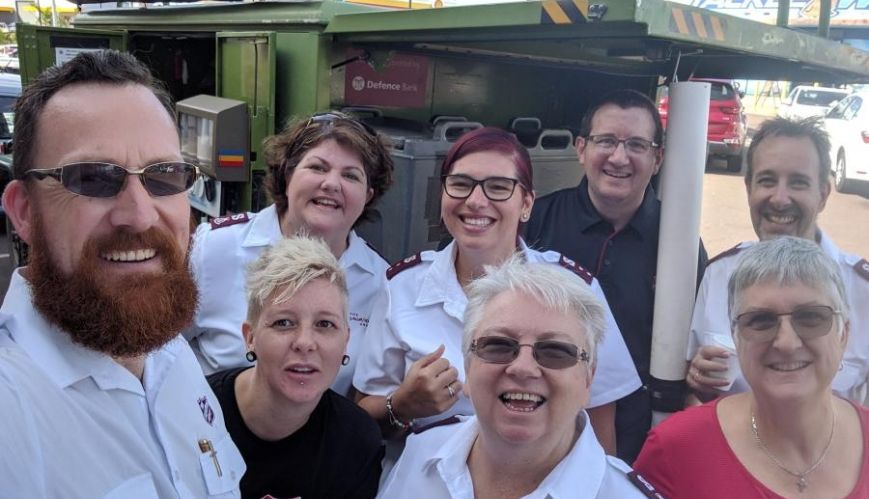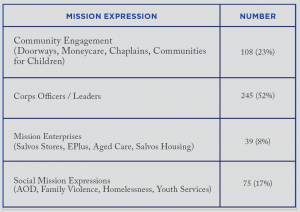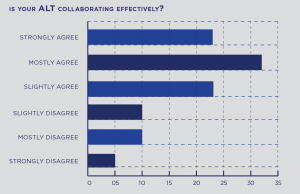Local Mission Delivery - successes and challenges

Local Mission Delivery - successes and challenges
26 March 2020
The Northern Territory’s Coolalinga Area Leadership Team (ALT) at a Salvos Store opening in May 2019.
Local Mission Delivery (LMD) is our way of working collaboratively in mission in a particular area. It is a new way for our different mission expressions to be intentionally meeting and working together in mission. An important forum for LMD is the Area Leadership Team (ALT).
Across Australia, 65 Area Leadership Teams meet every four to six weeks to collaborate in holistic mission – looking to serve the community with the love of Jesus in word and action. The teams include leaders from local mission expressions in a geographical area.
HOW DO WE KNOW IF WE ARE BEING EFFECTIVE WITH LOCAL MISSION DELIVERY?
One measure we use each year is to conduct an anonymous survey of all ALT members. At the end of 2019, we received over 470 responses. As the responses show (see graph) most participants on an ALT are corps officers. This can be a challenge to ensure that other mission expressions and non-officers feel included and not marginalised in these teams.
A key factor in effective collaboration is for people to feel valued by others and safe to raise issues in the ALT. The survey found that 91 per cent agreed they felt valued as members of the ALT and 86 per cent agreed they felt safe to raise issues at the ALT. This is a great foundation for healthy missional collaboration.

Indeed, there is increasing evidence of missional collaboration. Three-quarters of respondents feel that their ALT is collaborating effectively in holistic mission. Positively, ALT members identified stories of effective collaboration in holistic mission. A few examples are listed below:
1. Working with the local corps to provide a transition house for men leaving our service.
2. Proactively engaging with other expressions of the ALT for Easter weekend activities.
3. Moneycare is partnering with Communities for Children to provide outreach for clients who connect with Gunya Meta, an Aboriginal and Torres Strait Islander organisation.
4. Local corps working with the family violence service to facilitate a Mainly Music program and Christmas events.
5. Homeless Week joint program.
6. People from Doorways and Pathways connecting to the corps and attending chapel.
7. Corps has established a good partnership with a homelessness service. The chaplain is engaging with the corps and partnering with mission opportunities in the city.
8. During large-scale evacuation, the Salvos in the area knew one another, collaborated, supported, sacrificed and ‘pulled together’ to be one team.
9. The ALT has allowed for the forming of a close working relationship between EPlus and corps, allowing program to be developed.
10. Many participants of the Alcohol and Other Drugs community have been linked with local corps, youth services and Salvos Stores.
11. Court chaplain is providing group Positive Lifestyle Training with eight corps members.
12. ALT held a joint mission conference.
These are exciting initiatives in our services working together to serve their communities. At the same time, 25 per cent of survey respondents did not feel their ALT is collaborating effectively. Recurring feedback was that too much time can be spent at ALT meetings sharing information and networking rather than collaborating in mission.
This is a challenge in managing the time and agenda of the team meetings. Other respondents expressed a concern that their ALT can lack a clear purpose for their meeting. These are challenges that are being addressed by all area officers.

On another question, 63 per cent felt that the ALT explores innovative ways to create faith pathways for people. But that also means 37 per cent do not. Just as there are great examples of improving connections and referrals between different mission expressions, others indicated that they would like to see ALTs be more open to fostering innovations and initiatives.
As with any new way of working, ALTs have their strengths and their challenges. They are not all the same. Rural ALTs that are spread across large geographical areas find it difficult to develop practical ways to collaborate when they are so distant from one another. Some have a significant number of social mission services and few corps; others have a significant number of corps and few social mission expressions.
People are consistently enthusiastic about the value of collaborating and working together in mission. It is early days, and there are both strengths and challenges in facilitating holistic mission through our ALTs. It is exciting to see the different expressions of The Salvation Army working together in mission and looking to live out Paul’s encouragement to all of us: “Each of you should look not only to your own interests, but also to the interests of others. Your attitude should be the same as that of Christ Jesus” (Philippians 2:3-5).
As we work and live this way together, we will increasingly show the love of Jesus to others – and transform Australia one life at a time.
Rod Yule is General Manager, Local Mission Delivery and Resource, Mission Department.